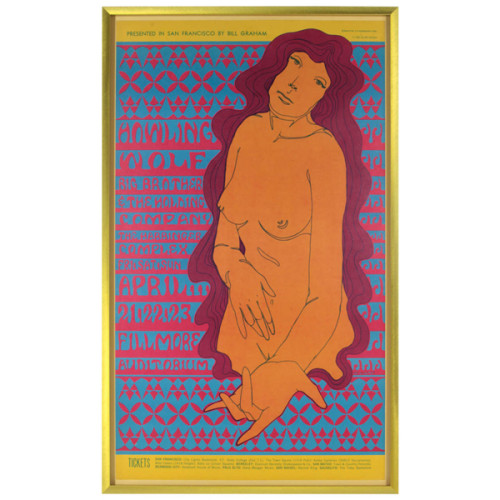Product Description
Wes Wilson, Howlin’ Wolf, Big Brother and the Holding Company, Harbinger Complex at the Fillmore, April 21-23, 1967, 1st edition



WES WILSON USA
Howlin’ Wolf, Big Brother and the Holding Company, Harbinger Complex at the Fillmore April 21-23, 1967
Marked: Wes Wilson #60 Creative Lithograph Co. ©1967 Bill Graham
H: 23 ¾” x W: 14”
Wes Wilson, Howlin’ Wolf, Big Brother and the Holding Company, Harbinger Complex at the Fillmore, April 21-23, 1967, 1st edition
BRASSAÏ (1899-1984) Austria-Hungary
“Transmutations 1934-35” 1967
Published by Lacoste: Galerie Les Contards, France.
12 gelatin silver prints each flush-mounted to a presentation folder with printed sequential number and title, with colophon contained in a linen covered, velvet lined clamshell folio with gilt lettering on the spine.
Signed and numbered 32 in ink on the colophon. This work is from an edition of 100. The titles include: I. Femme-fruit; II. Sevillane denudee; III. Odalisque; IV. Femme-mandoline; V. Femme-amphore; VI. Fille de Joie se Deshabillant; VII. Visage mineral; VIII. Tentation de Saint Antoine; IX. Jeune fille revant; X. Offrande; XI. Femme aux voiles; XII. Fete foraine.
Dimensions:
Book: H: 15 ½” x W: 12” x D: 1 ½”
Custom leather box: H: 17 ¾” x W: 13 ½” x D: 4 ½”
Custom silk slipcase: H: 18 ¾” x W: 14 ¼” x D: 6”
STEPHEN LONGSTREET (1907-2002) New York, NY
“Billie Holiday” c. 1970’s
Paper cut-out, mixed media and paper collage
